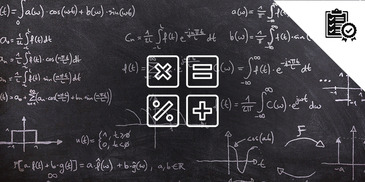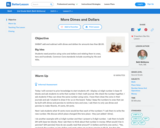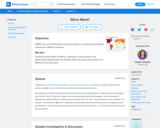
SWBAT use patterns on a 50 chart to identify missing numbers.
- Subject:
- Mathematics
- Material Type:
- Lesson Plan
- Provider:
- BetterLesson
- Date Added:
- 12/01/2022


SWBAT use patterns on a 50 chart to identify missing numbers.

SWBAT read and write numbers to 20..

SWBAT read and write numbers to 30.

Students need practice using coins and dollars and relating them to ones, tens and hundreds. Common Core standards include counting by 10s and 100s.

Students practice skills of addition, subtraction, word problems and graphing and develop their own theories about why meat consumption is so different across the world.

We are all called by more than one name. Lets find out if fractions can be too!

The big idea of this lesson is that three (or more) numbers can be grouped together and added. The order of this grouping doesn't matter.

The Common Core standard is that students understand that the numbers 100, 200, etc. represent so many groups of 100.

Grouping by tens reinforces the understanding of place value

Students always want to share! This lesson allows us to create a routine where everyone is safe in sharing their thinking and comfortable responding to another's presentation of understanding.

To make sense of numbers in the thousands, 2nd grade students need practice identifying place value positions and using place value strategies in numbers to 1,000.

Introduce students to decimals with this lesson. Students will explore how fractions can be changed to decimals with place value charts.

Help your students solve subtraction number sentences by using the part/part/whole model. This lesson shows students how to separate parts from a whole or by comparison to understand the subtraction number sentences. Lesson includes pictures and a video to support the implementation.

Students are expected to fluently multiply and divide within 100. This allows students to practice their math facts and then check their work using area models.

Counting by 10's is easy for students of this age. Knowing that base 10 can be used to help multiply and divide in the higher numbers by decomposing is critical. This lesson sets the base for future work.

Students calculate decimal quantities while making sense of real world situations.

Multiplication with decimals is a life skill used when making purchases and measuring.

Using a mathematical model, students will be able to visually see the process of how to multiply a fraction by a whole number to find its product in order to gain a deeper understanding to ultimately be able to do it on their own.

Students fluently multiply multi-digit decimal quantities.

How do you multiply decimals? Where does the decimal point go? Students work on answering these questions and developing an algorithm for multiplying decimals.